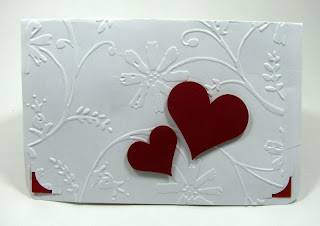Artėja Valentino diena, kai norime pasveikinti savo mylimus žmones. Gal norite pradžiuginti juos savo padarytu atviruku? Štai viena idėja. Atvertus atviruką, į priekį iššoka širdelė su gėlyte. Jei nenorite, galite gėlytės nepjaustyti, o tiesiog iškirpti dar vieną širdelę ir ją ant viršaus užklijuoti ar tiesiog nuspalvinti.
Projektui reikės: aštraus peiliuko, storo kartono ar keleto sluoksių popieriaus, ant kurio pasidėsite atviruką, kad neperpjautumėte stalo paviršiaus, liniuotės, klijų, raudono ir balto popieriaus. Aš baltą atviruko pagrindą padariau faktūrinį su Cuttlebug faktūriniais padėkliukais, o 2 1/2", 1 1/4 " ir 3/4" dydžio širdeles išpjoviau su Cricut Flantin SchoolBook komplektu.
Jei norite išpjaustyti širdelę pasinaudodamos mano sukurtu piešiniu, atsiųskite man savo elektroninio pašto adresą ir aš Jums pasiųsiu piešinuką. Jei norite pačios išsikirpti širdelę, tai visai lengva padaryti.
Nupieškite širdelę, tačiau apčioje padarykite širdelę plokščią, nes šioje vietoje ji laikysis prie atviruko pagrindo. Nuo širdelės viršaus padarykite tokias " petnešėles", kurios irgi laikys širdelę. " Petnešėlių" ilgis ir atviruko lenkimo linijos atstumas nuo pagrindo turi būti vienodas- šie atstumai pažymėti raide A. Aštriu peiliuku išpjaukite širdelę, tuomet išnaudotu tušinuku ( be rašalo), įbrėžkite punktyrines linijas ir per jas lenkite taip, kad širdelė pasistumtų į priekį. Teisingai sulankstyta širdelė tvarkingai suguls į plokščią atvirutę. Sulankstytą širdelę iš blogosios pusės patepkite klijais tik aplink atvirutės kraštus- būkit atsargūs ir nepatepkite klijais pačios širdelės, po to priklijuokite prie pagrindo ir padekoruokite atvirutės priekinę dalį. Telieka ušrašyti palinkėjimus ir pasiųsti mielam žmogui.
Gražios Valentino dienos.
Only few days left until Valentine's Day. Do you want to send a hand made Valentine's Card to someone so special? Here is an idea. Make your own Valentine's Card. You need a card file or your own heart picture- it is important to have the same distance ( marked A in the picture) from heart base to the folding line and from heart top to folding lines, x-acto knife, self healing pad, white and red paper, glue and a ruler.
Print a file and cut all continuous lines. Using an old pen ( no ink) score dotted and dashed lines. Start folding at a dashed line in the middle- here will be your card's folding line then fold at the bottom of a heart and on top of the heart. Gently fold these parts of the card pushing forward until it would drop flat.
Make a backing of the card, score to insert your heart or glue it on.
Decorate a front of the card. I used a Cuttlebug embossing plates to emboss one side of the card and Cricut cutout hearts 2 1/2", 1 1/4 " and 3/4" hearts from Flantin School Book set.
Happy Valentine's Day!















































